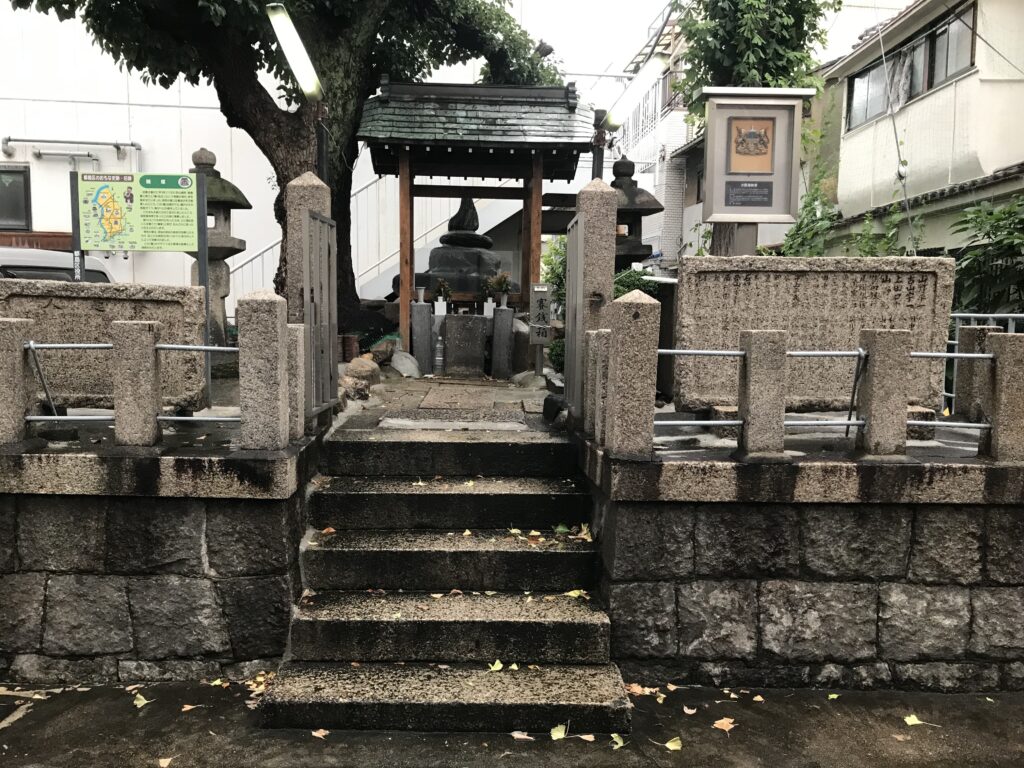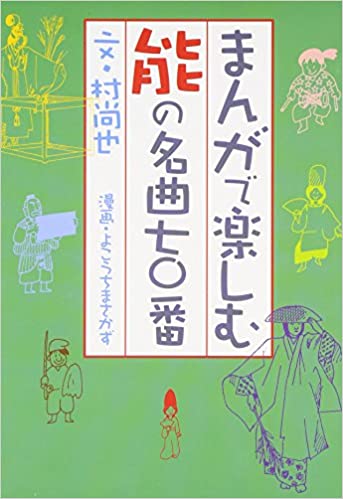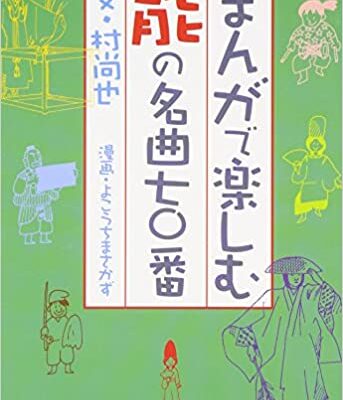村尚也 著 「まんがで楽しむ能の名曲70番」 檜書店
能って何? そんな素朴な質問をされて、答えることができるでしょうか? いや、見たことあると言える人も少ないのではと思います。私も残念ながら鑑賞の経験はありませんでした。様々な日本文化に触れようとインプットを増やしている中、最初に能に触れたのは、能楽師の林元大さんが講師をつとめられていた阪急トラピックスが大阪梅田で開講している講座でした。そこでは、本物の能面や衣装、また謡や舞を実演していただきました。いくつかのストーリーについても解説いただき、少しだけ興味を持てるようになりました。
その後、たまたま書店で出会ったのが本書「まんがで楽しむ能の名曲70番」です。購入後、長い間寝かせていましたが、一日2~3曲ずつ読もうと思い、読み始めました。各曲が4ページで構成されています。
最初に解説があり、次のページからマンガでストーリーの概略です。本物のストーリーを知らないので、どこまで正しいのか不明なのですが、わかりやすいようにかなりデフォルメされている印象はあります。
日本刀について調べていた時に知った、名刀 三日月宗近で有名な刀匠の小鍛冶宗近が、稲荷明神の使者の霊狐を相槌として、こちらも名刀「小狐丸」を打ち上げる話が、能にもあり、曲名は「小鍛冶」そのものであることを知りました。
また、昔の結婚式で必ず謡われていた「高砂や~」で有名な、その名も「高砂」という曲も掲載されています。高砂の松、と大阪の住吉の松が、どれほど離れていても夫婦なので、相生の松と言うそうです。別件で、実際に使われた忍者の合言葉を調べていた時、和歌や謡から作っていた合言葉の一例として、「松」といえば「高砂」という組み合わせもありました。なるほど、教養がないと忍者はつとまらないのかと思った次第です。
もう一つ、「鵺」という能の曲があります。源頼政が矢で射殺したストーリーをご存知の方も多いでしょうが、その鵺が淀川に流されて成仏できないでいるため、僧に回向(えこう)を望んだというものです。実は後日談があり、その鵺は現在の大阪市都島区辺りで引き上げられ供養されたらしく、鵺塚というものが造られています。家から近いこともあって、現地を訪れたところ、写真のようになっていました。私も、鵺が供養されることを祈ってきました。

70曲の概略ストーリーの中には、皆さんがご存知のものもあるかもしれませんね。(完)

価格:1,320円
(2021/5/9 12:14時点)
感想(5件)
Naoya Mura, “Enjoying Noh in Manga: The 70 Greatest Noh Plays,” Hinoki Shoten
What is Noh? If you were asked such a simple question, would you be able to answer? No, I’m sure there are not many people who can say they have seen it. Unfortunately, I have never had the experience of watching it either. While I have been increasing my input to experience various aspects of Japanese culture, the first time I came in contact with Noh was at a course offered by Hankyu Topics in Umeda, Osaka, where Noh actor Dai Hayashimoto was the instructor. He demonstrated real Noh masks, costumes, chanting and dancing. He also explained some of the stories, which made me a little more interested in the story.
After that, I happened to come across this book “Enjoying Noh Masterpieces in Manga No. 70” at a bookstore. I had put it down for a long time after purchasing it, but I decided to read two or three pieces a day, so I started reading it. Each piece consists of four pages.
There is an explanation at the beginning, and from the next page is an outline of the story in manga. Since I don’t know the real story, I’m not sure how much of it is correct, but I have the impression that it was deformed quite a bit to make it easier to understand.
When I was researching Japanese swords, I learned that there is a story in Noh about a swordsmith, Munechika Kokaji, who is famous for his famous sword, Mikazuki Munechika, who uses a spirit fox, an emissary of Inari Myojin, as a mallet to launch another famous sword, Kogitsune-maru, and that the name of the piece is “Kogaji” itself.
It also contains the famous song “Takasago,” the name of which was always chanted at weddings in the past. It is said that the pine tree in Takasago and the pine tree in Sumiyoshi, Osaka are called Aioi no Matsu because they are husband and wife no matter how far apart they are. In another case, when I was researching actual ninja watchwords, I found a combination of the word “pine” and the word “Takasago” as an example of a watchword made from Japanese poetry and chanting. It made me think that a ninja cannot be a ninja if he is not well educated.
There is another Noh piece called “Nue (White Sphinx)”. Many of you may know the story of how Minamoto-no-Yorimasa shot and killed a “Nue” with an arrow, and the Nue was swept away by the Yodo River and was unable to attain Buddhahood, so he asked a monk for help. In fact, there is a later story that he was pulled up in the area of present-day Miyakojima Ward, Osaka City, and a mound called the “White Sphinx Mound” was built for him. Since it was close to my house, I visited the place and found it as shown in the photo. I also prayed that the sphinx would be repaired.
Some of the stories outlined in the 70 songs may be familiar to you. (End)
Naoya Mura, “Enjoying Noh in Manga : Les 70 plus grandes pièces de théâtre nô,” Hinoki Shoten
Qu’est-ce que le Nô ? Si on vous posait une question aussi simple, seriez-vous capable d’y répondre ? Non, je suis sûr qu’il n’y a pas beaucoup de gens qui peuvent dire qu’ils l’ont vu. Malheureusement, je n’ai jamais eu l’occasion de le voir non plus. Alors que j’ai multiplié les occasions de découvrir divers aspects de la culture japonaise, la première fois que j’ai été en contact avec le nô, c’était lors d’un cours proposé par Hankyu Topics à Umeda, Osaka, où l’acteur de nô Dai Hayashimoto était l’instructeur. Il a montré de vrais masques et costumes de Nô, ainsi que des chants et des danses. Il a également expliqué certaines des histoires, ce qui m’a rendu un peu plus intéressé par l’histoire.
Après cela, je suis tombé par hasard sur ce livre “Enjoying Noh Masterpieces in Manga No. 70” dans une librairie. Je l’avais laissé de côté pendant longtemps après l’avoir acheté, mais j’ai décidé de lire deux ou trois morceaux par jour, alors j’ai commencé à le lire. Chaque morceau est composé de quatre pages.
Il y a une explication au début, et dès la page suivante, on trouve un résumé de l’histoire en manga. Comme je ne connais pas la véritable histoire, je ne suis pas sûr qu’elle soit correcte, mais j’ai l’impression qu’elle a été assez déformée pour être plus facile à comprendre.
Lorsque j’ai fait des recherches sur les sabres japonais, j’ai appris qu’il existe une histoire dans le nô sur un épéiste, Munechika Kokaji, célèbre pour son célèbre sabre, Mikazuki Munechika, qui utilise un renard spirituel, émissaire d’Inari Myojin, comme maillet pour lancer un autre sabre célèbre, Kogitsune-maru, et que le nom de la pièce est “Kogaji” lui-même.
Il contient également la célèbre chanson “Takasago”, dont le nom était toujours scandé lors des mariages dans le passé. On dit que le pin de Takasago et le pin de Sumiyoshi, à Osaka, sont appelés Aioi no Matsu parce qu’ils sont mari et femme, quelle que soit la distance qui les sépare. Dans un autre cas, lorsque j’ai fait des recherches sur les mots d’ordre des ninjas, j’ai trouvé une combinaison du mot “pin” et du mot “Takasago” comme exemple de mot d’ordre fait à partir de poésie et de chants japonais. Cela m’a fait penser qu’un ninja ne peut pas être un ninja s’il n’est pas bien éduqué.
Il existe une autre pièce de Nô appelée “Nue (Sphinx blanc)”. Beaucoup d’entre vous connaissent peut-être l’histoire de Minamoto-no-Yorimasa qui a tué un “Nue” avec une flèche. Le Nue a été emporté par la rivière Yodo et n’a pas pu atteindre l’état de Bouddha, il a donc demandé de l’aide à un moine. En fait, une histoire ultérieure raconte qu’il a été remonté dans la région de l’actuel quartier de Miyakojima, à Osaka, et qu’un monticule appelé “monticule du sphinx blanc” a été construit pour lui. Comme c’était près de chez moi, j’ai visité l’endroit et je l’ai trouvé tel que montré sur la photo. J’ai également prié pour que le sphinx soit réparé.
Certaines des histoires décrites dans les 70 chansons vous sont peut-être familières. (Fin)
